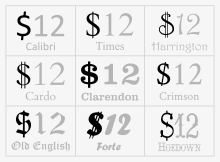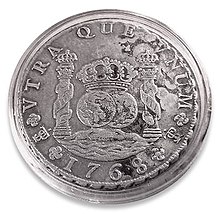Dollar sign
| $ | |
|---|---|
Dollar sign | |
| Other names | peso sign |
| In Unicode | U+0024 $ DOLLAR SIGN (HTML $ · $) |
| Currency | |
| Currency | many (see dollar, peso) |
| Graphical variants | |
 | |
The dollar sign is a symbol consisting of a capital "S" crossed with one or two vertical strokes ($ or ), used to indicate the unit of various currencies around the world — including most currencies denominated "peso" and "dollar". The sign is also used as an element of several compound currency symbols, such as the Brazilian real (R$) and the Nicaraguan córdoba (C$).
The one- and two-stroke version are often considered mere stylistic (font) variants, although in some places and epochs one of them may have been specifically assigned, by law or custom, to a specific currency. The Unicode computer encoding standard defines a single code for both.
In most English-speaking countries that use that symbol, it is placed to the left of the amount specified, e.g. "$1", read as "one dollar".
History[]
Use for the Spanish American peso in the late 1700s[]
The symbol appears in American, Canadian, Mexican, Spanish American, and other British business correspondence in the 1770s, referring to the Spanish American peso,[1][2] also known as "Spanish dollar" or "piece of eight" in the English America. Those coins provided the model for the currency that the United States adopted in 1792, and for the larger coins of the new Spanish American republics, such as the Mexican peso, Peruvian real, and Bolivian sol coins.
With the Coinage Act of 1792, the United States Congress created the U.S. dollar, defining it to have "the value of a Spanish milled dollar as the same is now current"[3] but continued to use a variety of foreign coins until the Coinage Act of 1857 declared them illegal.[4][5]
The earliest US dollar coins did not have any dollar symbol. The first occurrence in print is claimed to be from 1790s, by a Philadelphia printer Archibald Binny, creator of the Monticello typeface.[6] The $1 United States Note issued by the United States in 1869 included a symbol consisting of a "U" with the right bar overlapping an "S", as well as the double-stroke dollar sign in the legal warning against forgery.[7]
Earlier history of the symbol[]
It is still uncertain, however, how the dollar sign came to represent the Spanish American peso. There are currently several competing hypotheses:
- One theory holds that the sign grew out of the Spanish and Spanish American scribal abbreviation "ps" for pesos. A study of late eighteenth- and early nineteenth-century manuscripts shows that the s gradually came to be written over the p, developing into a close equivalent to the "$" mark.[8][9][10][11][12] However, there are documents showing the common use of the two-stroke version in Portugal already by 1775.[13]

- Another hypothesis derives the sign from a depiction of the Pillars of Hercules, a classical symbol for two sides of the Strait of Gibraltar, with a ribbon wrapped around both each pillar (or both pillars) in the form of an "S". This device is common support element of the Spanish coat of arms, and appeared on the most common real de ocho coins circulating at the time in the Americas and Europe; namely, those minted at the Potosí mint in Bolivia, which operated from 1573 to 1825.[14][10] Indeed, one of the names used for Spanish dollars in Qing Dynasty China was shuāngzhù (双柱, 雙柱), "double-pillar".[15]
- A variant of the above theory claims that the sign comes from the mark of the mint at Potosí, where a large portion of the Spanish Empire's silver was mined, also featured on those coin, which consisted of the letters "P T S I" superimposed. The core of this monogram is a (single-stroked) "$" sign.[16]
- Yet another hypothesis notes that the English word "dollar" for the Spanish piece of eight originally came (through Dutch daaler) from Joachimsthaler or thaler, a similar large German silver coin was widely used in Europe. It is therefore conjectured that the dollar sign derived from a symbol consisting of a superimposing S and I or J that was used to denote the German silver coin. Such symbol appears in the 1686 edition of An Introduction to Merchants' Accounts by John Collins.[17] Alternatively, the symbol would have came from a snake and cross emblem on the thaler coins.[6]
Less likely theories[]
The following theories seem to have been discredited or contradicted by documentary evidence:
- Some historians have attributed the symbol to Oliver Pollock, a wealthy Irish trader and early supporter of the American Revolution, who used the abbreviation "ps", sometimes run together, in a letter dated 1778.[6][18]
- In 1937, historian James Alton James claimed that the symbol with two strokes was an adapted design of patriot Robert Morris in 1778, in letters written to Pollock.[19][20][18]
- In 1939, H. M. Larson suggested that the sign could derive from a combination of the Greek character "psi" (ψ) and "S".[21]
- Writer Ayn Rand claimed in her 1957 book Atlas Shrugged that the sign started off as a monogram of "US", with a narrow "U" superimposed on the "S", which would have been used on money bags issued by the United States Mint. In her theory, the bottom part of the "U" would have been lost, producing the dollar sign with two vertical lines.[22][6]
- Authors T. Seijas and J. Frederick noted that the captors of slaves in Spanish territories sometimes branded enslaved people with a symbol very similar to a one-barred dollar sign. Esclavo is Spanish for "slave," and clavo means nail. A dollar sign is S + clavo.[14]
- A theory often cited in Portuguese speaking countries is that the "S" part of the doubly-stroked sign is a schematic representation of the path followed by the Umayyad Caliphate general Tariq Ibn Ziyad in his conquest of the Visigoth kingdom in 711 CE, and the two strokes represent the Pillars of Hercules that he would have crossed along that path. That symbol would have been engraved in coins commemorating his victory, and then became symbolic of currency in general.[23]
Currencies that use the dollar sign[]
As symbol of the currency[]
The numerous currencies called "dollar" use the dollar sign to express money amounts. The sign is also generally used for the many currencies called "peso" (except the Philippine peso, which uses the symbol "₱").
The dollar sign, alone or in combination with other glyphs, is or was used to denote several currencies with other names, including:
- Brazilian cruzeiro (various currencies, all defunct): ₢$, Cr$, NCr$, etc.
- Brazilian real: R$
- Nicaraguan córdoba: C$
- Samoan tālā (a transliteration of the word dollar): $
- Tongan paʻanga: T$
- Malaya and British Borneo dollar (1957–1967): $
- Malaysian ringgit (1967–1997): $, M$
In the United States, Mexico, Australia, Argentina, New Zealand, Hong Kong, Pacific Island nations, and English-speaking Canada, the sign is written before the number, even though the corresponding word is written or pronounced after it. "Five dollars" or "cinco pesos" is written and printed as "$5". (On the other hand, the cent symbol in many of those countries is written after the number, as in "5¢"). In French-speaking Canada, exceptionally, the dollar symbol usually appears after the number, as in "5$".
Use in the Portuguese Empire[]
In Portugal, Brazil, and other parts of the Portuguese Empire, the two-stroke variant of the sign (with the name cifrão) was used as the thousands separator of amounts in the national currency, the real (plural "réis", abbreviated "Rs."): Rs. meant "123 500 réis". This usage is attested in 1775, but may be older by a century or more.[13]
In 1911 Portugal redefined the national currency as the escudo, worth 1000 réis, and divided into 100 centavos; but the cifrão continued to be used as the decimal separator,[24] so that meant 123.50 escudos or 123 escudos and 50 centavos. This usage ended in 1999 when the country switched to the euro.

Cape Verde, a Portuguese colony since the late 1400s, similarly switched from the real to their local escudo and centavos in 1914, and retains the cifrão usage as decimals separator as of 2021. Local versions of the Portuguese escudo were for a time created also for other overseas colonies, including East Timor (1958–1975), Portuguese India (1958–1961), Angola (1914–1928 and 1958–1977), Mozambique (1914–1980), Portuguese Guinea (1914–1975), and São Tomé and Príncipe (1914–1977); presumably all using the cifrão as decimals separator.
Brazil retained the real and the cifrão as thousands separator until 1942, when it switched to the Brazilian cruzeiro, with comma as the decimals separator. The dollar sign, officially with one stroke but often rendered with two, was retained as part of the currency symbol "Cr $", so one would write Cr$13,50 for 13 cruzeiros and 50 centavos.[25]
Fictional currencies[]
Some virtual world and gaming platforms have used the $ symbol to refer to their own virtual currencies, for example:
- R$ – Robux (Roblox)
- S$ – Sansar Dollars (Sansar)
- L$ – Linden Dollars (Second Life)
- M$ - Minecoins (Minecraft) (Exclusive to Bedrock Version)
One stroke vs. two strokes[]
In some places and at some times, the one- and two-stroke variants have been used in the same contexts to distinguish between the U. S. dollar and other local currency, such as the Portuguese escudo,[24] or the Mexican peso.[citation needed].
However, such usage is not standardized, and furthermore the two versions are generally considered mere graphic variants of the same symbol. Computer and typewriter keyboards usually have a single key for that sign, and many character encodings (including ASCII and Unicode) reserve a single numeric code for it. Indeed, dollar signs in the same digital document may be rendered with one or two strokes, depending on the fonts used. Should that ambiguity be significant, one may use explicit abbreviations (like "US$" or "$NZ"), or ISO 4217 three-letter currency codes (such as USD and MXN) to distinguish different currencies that use the symbol.
When a specific variant is not mandated by law or custom, the choice is usually a matter of expediency or aesthetic preference. Both versions were used in the US in the 18th century. (A 1861 Civil War era advertisement depicts the two-stroked symbol as a snake.[18]) The two-stroke version seem to be generally less popular today, though used in some "old-style" fonts like Baskerville.
Use in computer software[]
Because of its use in early American computer applications such as business accounting, the dollar sign is almost universally present in computer character sets, and thus has been appropriated for many purposes unrelated to money in programming languages and command languages.
Encoding[]
The dollar sign "$" has Unicode code point U+0024 (inherited from ASCII via Latin-1).
There are no separate encodings for one- and two-line variants. The choice is typeface-dependent, they are allographs. However there are three other code points that originate from other East Asian standards: the Taiwanese small form variant, the CJK fullwidth form, and the Japanese emoji. The glyphs for these code points are typically larger or smaller than the primary code point, but the difference is mostly aesthetic or typographic, and the meanings of the symbols are the same.


